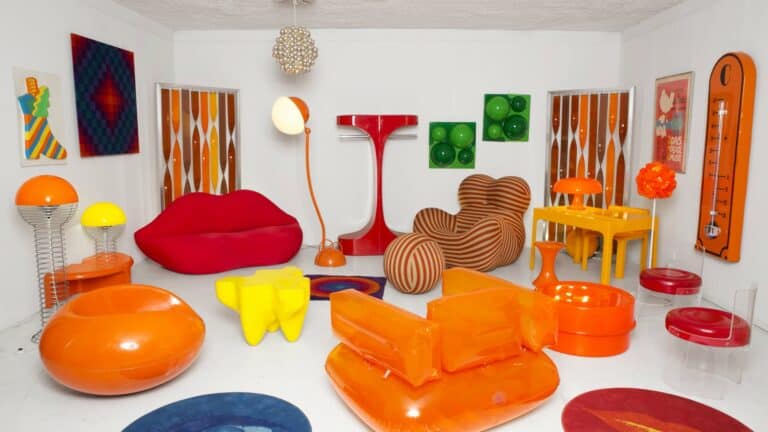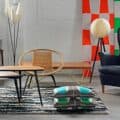True retro style decorating actually encompasses several decades of styles. And the term itself is used to describe almost any interior design theme that is influenced by trends and styles from the past. While this definition means that any era can be considered retro, the term is most commonly used to describe decor from the 1950s, 60s, and 70s. If you go further back, you’re headed more towards vintage style, although the two styles often intersect.
Retro style interior design usually has a fun and lively feel. It features bright colors, wild patterns, and an overall sense of elegance. If you think about the fabrics and textures of the 1960s you will immediately get an idea of where your decorating needs to go to really capture the essence of retro style. Because retro design requires a rather bold approach, it also requires some personality to be successful. There’s nothing casual or minimalist about retro style decorating. Instead, it’s garish, busy, and most definitely funky.
What is retro style?
The characteristics of retro style in interior design are:
- Orientation to the fashion trends of the 50s to 70s.
- Use of synthetic materials (plastics, synthetic fabrics, PVC, etc.).
- Bright colors.
- Vintage decorative elements like decorative vinyl records, old-fashioned textiles, vintage wall clocks, lamps and vases from the last century, thick carpet, chrome door handles.
- Unusual furniture shapes.
- Tendency to abstract style and forms.
Retro style in interior design is composed of odd shapes and combinations of colors and textures, brightness, and originality. Like for instance plastic figurines and vinyl records, paintings and photographs of cities, lava lamps and sofas shaped like lips, a combination of glass, plastic, metal, and synthetic materials (artificial leather and velvet), beaded curtains and asymmetrical patterns.
Tips for using retro style in decorating
You can bring retro style interior decorating to your home or apartment with some common elements of this energizing decorating style:
How to use furniture to create a retro feel in decorating
Retro style furniture has panache, each almost fighting for the spotlight as the focal point of the room. Sofas are wide and elongated with multi-colored cushions for an extra touch of color. Shiny chrome bar stools with bright red seats draw your attention to an open bar or kitchen while Mitt chairs offer unique seating for guests.
How to use colors to create a retro feel in decorating
One of the most straightforward ways to give a room a retro feel is to choose retro colors. Luckily, this isn’t difficult to do. Avocado green is the most popular retro color choice by far, followed by mustard yellow and combinations of brown, black, white and red. Also, purple and hot pink both make a great complement to your retro decor. Do not be surprised to find retro interiors that have a little bit of everything, with blends of bright orange, green, indigo blue and yellow in one room. Dyed fabrics, elaborate paisley (also known as paisley) and plaid patterns were also a hallmark of the era.
How to use textures to create a retro style in decorating
This is one area where retro style decorating really goes a step further. When you think of retro style, the first thing that comes to mind is shag carpeting, smooth plastics, soft vinyl and crushed velvet. Just keep in mind that everything is edgy when you decorate in a retro style, so don’t be scared of textures. The more the better.
How to use accents and flooring to create a retro feel in decorating
A popular aspect of retro style interior decorating is there are no boundaries when you talk about accents and accessories. Retro accessories include thick rugs, chrome door handles, lava lamps, skateboard tables and scoop stools. Art and sculptures are generally bold and uncommon, tilting more toward abstract pieces rather than simple sceneries and still lives. There are only three flooring options when choosing retro-style decor: natural wood, shag carpeting and a bold mix of different tiles arranged in a checkerboard pattern.
How to use lighting to create a retro style in decorating
Floor lamps and lamps with tassel or square shades are both great retro choices. Or consider a multi-colored swag chandelier that can be plugged into a wall socket and has a cord hanging from one hook to the other.
Making all the elements work together
Retro style decorating is about mixing a variety of shapes, textures and colors to produce a look as singular as the era that influenced it. Retro furniture is robust, long-lasting and usable. Everything is useful and functional. Crafting a retro style decor requires attention to every detail. The important thing to remember when it comes to retro design is to clear your mind of any inhibitions you may have about combining colors and shapes. Don’t try to soften a retro style decor. If you love the retro look, be prepared to go all the way.
The difference between retro style and vintage
It’s the big decorating trend of the moment: the words “retro” and “vintage” are everywhere. But do we really know what they mean? If everyone understands that they are a reference to fashion, architecture, music, or aesthetic codes of the past, do “retro” and “vintage” really mean the same thing? If not, what is the difference between these two terms?
Vintage and retro styles are very popular in the field of interior design. This type of decoration is composed of objects and furniture from the past, reproduced or period, assembled in contemporary decor. But is there really a difference between “retro” and “vintage”? If the two words exist, we suppose so.
A definition with variable scope
However, it’s hard to find the right definition among all the definitions scattered on the internet. For most collectors, retro furniture can be considered vintage, but not antique. But not everyone seems to agree on the respective definitions of each of these words. What is certain is that they do not mean exactly the same thing but, depending on the source, the definitions vary slightly.
- Retro defines a style evocative of the past, seeking to reproduce an atmosphere, codes or objects of the time. The retro style has developed strongly in the 90s with the reproduction of old billboards and posters used for decoration, or the return of bow ties, suspenders and “midi” skirts in the fashion field. This is a desire to make reference to the old, to make a wink to the past by integrating certain details in the present trends, without using objects of the time. Retro also refers to new objects copying old ones, which is not the case with vintage.
- The term vintage refers to an object, a garment, a material that is less than 100 years old and refers to furniture made in the 20th century. “Vintage” refers to authenticity and defines an object really made in a bygone era. To be vintage, an object must have been manufactured several decades ago.
Conclusion
To summarize, retro defines a style, a universe, or a concept of imitation or reproduction of the past. The retro style evokes and revives the last decades by borrowing from a specific era its codes and certain aesthetic details while integrating them into the contemporary world. The popular emblem of the retro style is for example the pin-up of the 50s hanging on the wall. Vintage defines not a style but a period piece.
By definition, you can’t give your home a vintage look. But you can give it a retro style by integrating vintage objects and furniture (actually made at the time), or retro (i.e. new objects imitating those of the time!).



